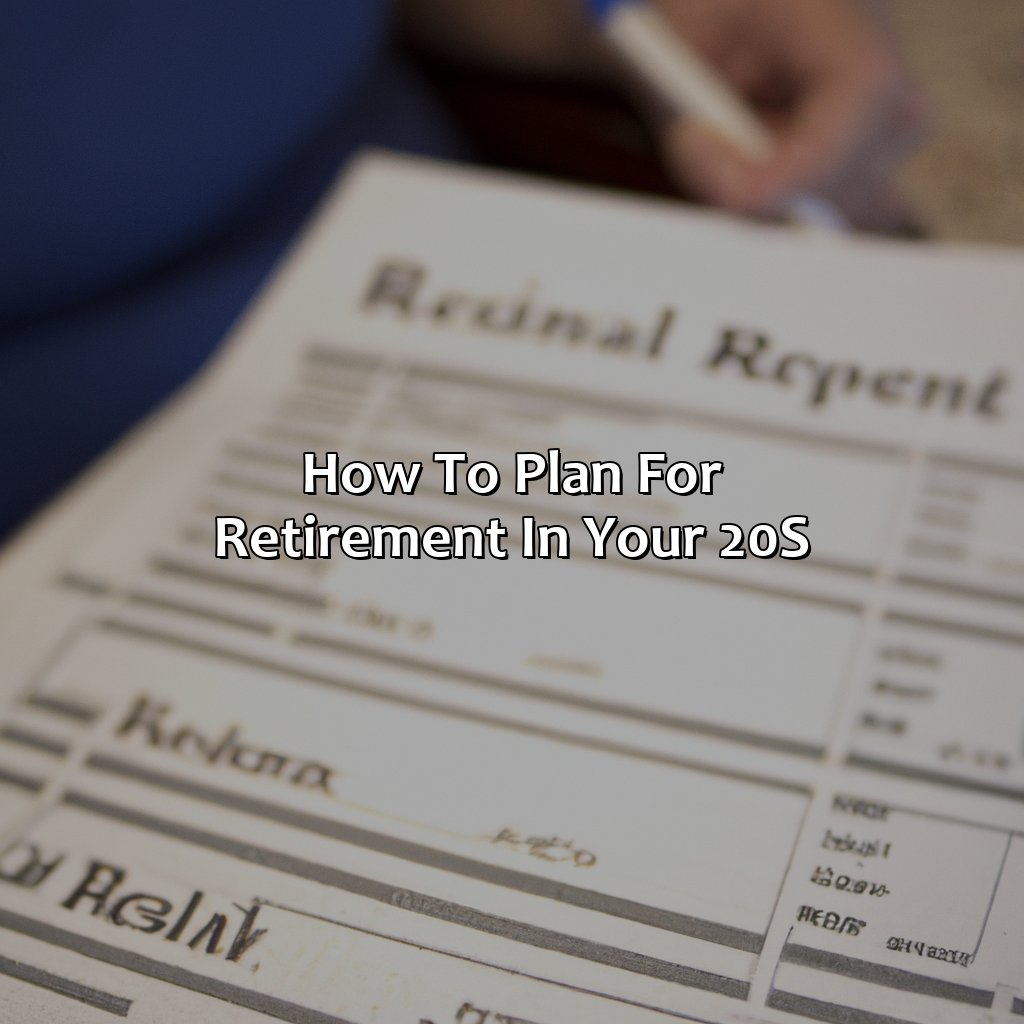How To Plan For Retirement In Your 20S?
Key Takeaways:
- Retirement planning in your 20s is crucial for secure financial future: Starting early can help in accumulating a larger corpus and reducing financial burdens during retirement.
- Factors to consider- goal setting, determining the amount to be saved, understanding investments and risk, and managing debts. These factors should be taken into account when planning for secure retirement.
- To take action: start saving now, maximize employer-sponsored retirement plans, open an Individual Retirement Account (IRA), review and adjust your retirement plan regularly, and consider future expenses and lifestyle changes.
Are you worried about planning for your retirement in your 20s? Don’t wait till it’s too late. Here are the key steps you can take now to ensure a secure future!
Importance of Retirement Planning in your 20s
As a young adult, it is crucial to consider the Importance of Retirement Planning early on. Planning for retirement in your 20s can seem daunting, but it sets the foundation for financial stability and security in the long run. By starting to save and invest in your early years, you have more time to build wealth and benefit from compound interest. A proactive approach to retirement planning can also help alleviate stress and anxiety about the future.
Continuing on the topic, developing a retirement plan in your 20s has numerous benefits. It allows you to determine how much money should be saved each month or year to meet your retirement goals without compromising your current financial stability. Young adults also have access to retirement saving plans such as 401(k)s, IRAs, and others that can yield long-term benefits. The earlier you start investing in retirement savings, the more time your savings have to grow. This can result in a more substantial nest egg and a more comfortable life during retirement.
It is important to note that retirement planning isn’t just about finances. It also includes plans for your lifestyle and health in old age. As you plan, you should consider your preferred retirement age, living arrangements, and health costs. Having a clear vision of your retirement can help guide your financial decisions and long-term life goals.
I recently met a retired man who had started saving for retirement in his 20s. He shared that he never wanted to rely solely on his social security benefits and knew that starting early would give him a better chance of reaching his retirement goals. Now that he is in his 70s, he enjoys financial security and the ability to pursue his hobbies and interests without the stress of financial hardships. His forethought and planning during his early years helped him achieve financial stability and peace of mind in retirement.

Image credits: retiregenz.com by Harry Washington
Factors to consider in Retirement Planning in your 20s
In your twenties? Planning for retirement made easy! Think about: goal-setting, how much to save, investments + risk, and managing debts. These are the key aspects you need to explore for a secure future.

Image credits: retiregenz.com by Yuval Duncun
Starting with goal-setting
Beginning with goal-setting is an essential aspect of formulating a robust plan for retirement during your 20s. To ensure a secure future, it’s crucial to have clear financial objectives that outline the path you must take to achieve your desired outcome.
Here’s how you can start goal-setting:
- Define your long-term goals: Identify what you want to achieve from your retirement plan in the long run.
- Create short-term goals: Break down these long-term goals into smaller objectives and targets that align with your monthly or yearly budget, this will motivate you towards achieving them;
- Keep track of progress: Review and monitor whether the goals are being achieved as planned periodically.
Additionally, decide how much money you want to save annually, make a strict budget and try to follow it accordingly. It is also essential to consider potential risks like inflation or any other emergencies that may crop up before retirement.
Retirement planning is holistic and requires a thorough understanding of what one wants to achieve; every individual has different requirements. Therefore, make sure you anticipate milestones like health care costs, future investments and liabilities, etc., while setting your financial goals.
Saving for retirement in your 20s is like trying to catch a unicorn – it seems impossible, but you’ll regret it if you don’t try.
Determining the amount to be saved
Retirement planning in your 20s necessitates determination of the total amount of money to be saved towards your retirement. This process involves considering factors such as expected retirement age, life expectancy, and lifestyle expenses.
To determine the amount to be saved, an individual needs to identify their post-retirement income needs while factoring inflation and future expenses. Experts suggest saving at least 15% of one’s income towards this goal. Early investment into a well-diversified portfolio also helps in achieving long-term financial stability.
Additional considerations include any existing debts and liabilities that may impact retirement savings. It is crucial to ensure that credit cards and loans are paid off before committing to regular savings.
Pro Tip: Reassessing your retirement plan regularly will help you adjust for changing circumstances and factor in new goals or unexpected expenses.
Some people gamble their retirement savings on risky investments, while others just hope they hit the jackpot at the casino.
Understanding investments and risk
Understanding the Connection between Investments and Risk is vital for Retirement Planning. Choosing to invest comes with a certain amount of risk. Assessing your tolerance for risk is key in choosing investment vehicles. Investment options such as stocks or mutual funds have substantial risks, while bonds may produce low returns that do not keep up with inflation. A financial advisor can help determine a prudent mix of varied investments based on personal goals, time horizon, and risk appetite.
To minimize the Risk, Diversification is essential. Investing all money in one stock or one industry invites unnecessary volatility. With diversification, investors hold different types of assets that tend to perform differently under different market conditions. A diversified portfolio may buffer against swings in market value that investing in any single security could cause.
It’s crucial to be aware of the impact of Inflation on investment earning potential over time during Retirement Planning. It affects everything from retirement income stream levels to portfolio construction decisions and withdrawal rates’ sustainability. Investors must consider the effects of inflation and adjust their expectations accordingly.
According to Investopedia, Bonds represent Debt obligations investors purchase from companies or governments looking for financing opportunities and yield attractive rewards compared with other bond classes in an environment where decreasing interest rates are driving bond prices up [Investopedia].
Debt is like a bad romance, but instead of flowers and chocolates, it brings bills and stress.
Managing debts
Effective Management of Financial Obligations
Reducing debts is an essential factor to consider in achieving long-term financial stability. By taking control of your finances early on, you can avoid falling prey to high-interest loans and credit card debts that will compromise your financial freedom in the future. As a young adult, it is crucial to manage your expenses effectively and plan ahead to guarantee debt-free living.
Analyze your monthly expenses and formulate a budget based on income, prioritizing essential costs such as food, rent, and utilities. Whenever possible, cut back on discretionary spending such as entertainment or dining out. Build up savings that you can rely on for emergency situations, so you do not have to resort to expensive loans.
Proactively seeking ways to lower loan payments by consolidating them into one manageable payment per month or negotiating with creditors can also play an essential role in reducing overall debt burden.
Taking these steps in managing financial obligations can pave the way for better retirement planning options later on.
Pro-tip: Consider opting for low-interest debt alternatives like personal loans from reputable lenders if larger expenditures arise rather than relying solely on credit cards with high interest rates.
Start saving now or you’ll be eating dog food in your golden years, and not the fancy kind.
Actions to take for Retirement Planning in your 20s
Start planning for retirement now! Check out this section for help – Actions to take in your 20s. Here you can find solutions for prepping for retirement. The sub-sections include:
- Start saving
- Maximize employer-sponsored retirement plans
- Open an Individual Retirement Account (IRA)
- Review and adjust your retirement plan regularly
- Consider future expenses and lifestyle changes

Image credits: retiregenz.com by Adam Duncun
Start saving now
Immediate Action for Securing Financial Independence in 20s
Saving is crucial for financial planning, especially during one’s 20s. Establishing a cash reserve and investing at an early age can be the key to building substantial wealth.
Here are four points to consider when starting to save:
- Set a Budget: Create a budget that enables you to monitor your monthly expenses.
- Begin Investing: Start contributing to your employer-sponsored retirement plan and invest in a diversified portfolio.
- Limit Debt: Avoid accumulating too much debt as it affects savings potential.
- Stay Educated on Financing: Consistently learn more about personal financing by attending workshops or online classes.
Building good financial habits early-on is vital, so take control of your spending-spree nature now. By doing so – you will secure your future independence.
Starting early is beneficial because the longer savings have to compound and increase, the easier it becomes towards retirement. Ensure personal investments align with long-term objectives while avoiding unnecessary risks.
A colleague of mine started investing half their yearly income from their first job since her twenties. Currently happily retired before they even turned fifty because of years of consistent saving that helped accumulate substantial wealth.
Retirement plans sponsored by your employer are like free candy – take as much as you can without getting sick.
Maximize employer-sponsored retirement plans
For optimal preparation of post-career life, leveraging the retirement benefits offered by an employer is crucial. Maximizing the full potential of such programs can make a world of difference in ensuring future economic stability. Here are some ways to make the most out of these plans:
- Explore available employer-sponsored retirement options such as 401(k)s and ask about matching contributions or other incentives.
- Start consistently allocating funds for retirement; generally, the earlier you begin, the better off you’ll be.
- Take advantage of compound interest by keeping the money invested for longer periods (time in market) working towards financial goals.
- Set up automatic contribution payment options or boost retirement service incentives to regularly channel savings into your account with minimal administration on your part.
To truly maximize employing-sponsored retirement opportunities, implementation is key. By breaking down common schemes and strategies, individuals can take more practical steps toward securing their finances for post-work years without any added stress. In addition to basic tips outlined above:
A good way to minimize tax liabilities is by making pretax contributions when possible; it’s one way employees may lower taxable wages while benefiting from proactive wealth management.
Finally, numerous studies have confirmed that people who invest early in their lives see significant returns. Embarking upon this path early sets a solid foundation which supports physical comfort and satisfaction for agedness such as vacation at desired places, stress-free healthcare services. Secure your future by opening an IRA, because you can’t rely on winning the lottery or finding a rich spouse to retire with.
Open an Individual Retirement Account (IRA)
Establish your Retirement Savings Plan by setting up a personal savings account. This can be done through an investment broker, bank or credit union. Be sure to have a clear understanding of the fees charged on the account.
Here’s a 4-step approach to setting up your retirement plan:
- Choose between Traditional or Roth IRA, depending on your income and tax bracket.
- Select a brokerage firm and create an account.
- Decide how much money you want to contribute annually.
- Select how investments are made- either with professional help through an advisor or self-managed funds.
Remember, there are unique benefits attached to opening an individual retirement account (IRA). These accounts are regulated by the IRS and FDIC, allowing for protection and security against economic uncertainties.
Using mutual funds is recommended for novices as seasoned investors may have more favorable returns elsewhere.
A friend of mine started their IRA in college. They invested $2,000 each year into it and continued that until they were 30 years old when they got injured at work. Since he had set up his IRA before he was injured, he could continue making contributions while being out of work for several months. It gave him peace of mind that he would have some sort of secured retirement income when he reaches his golden years.
Retirement plans are like diets – they only work if you stick to them and don’t cheat too often, but unlike diets, there’s no going back if you fail.
Review and adjust your retirement plan regularly
It is important to consistently evaluate and modify your retirement strategy. Regularly assessing your retirement plan will ensure it aligns with your current financial situation, long-term objectives and helps mitigate potential risks. Continuously adapting your investment portfolio allocation and savings contributions can safeguard against unanticipated market changes. Similarly, reviewing retirement income sources, such as social security benefits or employer-sponsored plans, may reveal opportunities for bolstering retirement funds.
To enhance your assessment, aim to identify gaps like incorrectly timed risk diversification or inadequate savings. If implementing necessary modifications appear overwhelming, consider consulting with a financial advisor who can provide professional insights into aspects of the process that needs additional attention.
Pro Tip: Ensure your review frequency matches expected market volatility or major life changes that could affect retirement goals.
Retirement planning in your 20s is like investing in an insurance policy for your future wrinkles and aching joints.
Consider future expenses and lifestyle changes
As you initiate your retirement planning journey in your 20s, it’s essential to contemplate the potential future costs and lifestyle shifts. Understanding and preparing for these changes early on can aid in avoiding surprises and inadequate funds after retirement.
To start, assess your present expenses and create a realistic budget to estimate any daily expenditure adjustments required as you age. Analyze the possibility of significant life events like homeownership or child-rearing that could demand considerable financial commitments during this period.
It’s vital to identify long-term goals, including targets for savings and investment plans based on personal requirements. Reviewing and adjusting financial plans with professional advice can offer guidance, extend savings without risk, ensure maximum returns, optimize tax benefits and avoid debt accumulation.
Meticulous record-keeping along with cost-cutting practices such as minimizing credit card usage or unnecessary spending may significantly contribute towards saving more money for the future. Don’t forget to set up emergency funds for unexpected situations that would divert focus from saving toward crises management in an emergency.
Realizing possible alterations in lifestyle that reduce expenses without compromising quality of life is another approach to manage money effectively. Developing healthy habits like cooking at home instead of eating out regularly or using eco-friendly transportation options not only saves money but also promotes beneficial environmental practice.
Some Facts About How To Plan For Retirement in Your 20s:
- ✅ Starting to save for retirement in your 20s can greatly increase your chances of having enough money to retire comfortably. (Source: CNBC)
- ✅ Creating a retirement plan and setting goals early can help you stay on track and make informed financial decisions. (Source: Forbes)
- ✅ It’s important to pay off high-interest debt and build an emergency fund before focusing on retirement savings. (Source: NerdWallet)
- ✅ Utilizing employer-provided retirement plans, like 401(k)s, is a smart way to save for retirement and take advantage of employer contributions. (Source: Investopedia)
- ✅ Investing in diversified and low-cost index funds can help maximize returns and minimize risk in your retirement portfolio. (Source: The Balance)
FAQs about How To Plan For Retirement In Your 20S?
1. Why is it important to plan for retirement in your 20s?
Planning for retirement in your 20s gives you more time to save and invest, which can result in a more comfortable retirement. By starting early, you also have the benefit of compound interest, which means your money can grow more quickly over time.
2. How much should I be saving for retirement in my 20s?
It’s recommended that you save 10-15% of your income for retirement in your 20s. However, the exact amount will depend on your individual financial goals and lifestyle. It’s important to create a budget and plan to save as much as you can while still meeting your current expenses.
3. What are some retirement savings options for those in their 20s?
Some retirement savings options for those in their 20s include 401(k) or 403(b) plans offered by employers, Roth IRAs, and traditional IRAs. It’s also important to consider investing in low-cost index funds or exchange-traded funds (ETFs) for added diversification.
4. What if I have debt in my 20s – should I still prioritize retirement savings?
While it’s important to pay off debt, it’s also important to start saving for retirement as early as possible. A good rule of thumb is to focus on paying off high-interest debt first, then prioritize retirement savings. It’s a balance, but the earlier you start saving for retirement, the better.
5. Can I adjust my retirement plan as I get older?
Absolutely. It’s important to regularly assess your retirement plan and adjust as necessary. Life circumstances and financial situations can change, so it’s important to stay flexible and be willing to adjust your plan accordingly.
6. What resources are available to help me with retirement planning in my 20s?
There are many resources available to help with retirement planning in your 20s, including financial advisors and online tools and calculators. It’s important to do your research and find resources that align with your individual financial goals and needs.







